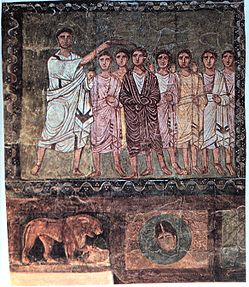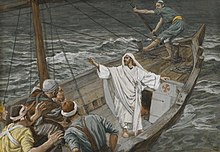The Gospel According to Matthew
The Gospel According to Matthew[ is the first book of the New Testament and one of the three synoptic gospels. It tells how Israel's Messiah, rejected and executed in Israel, pronounces judgement on Israel and its leaders and becomes the salvation of the gentiles.The gospel reflects the struggles and conflicts between the evangelist's community and the other Jews, particularly with its sharp criticism of the scribes and Pharisees:[2] prior to the Crucifixion they are referred to as Israelites, the honorific title of God's chosen people; after it, they are called simply Ioudaioi ("Jews"), a sign that through their rejection of the Christ the "Kingdom of Heaven" has been taken away from them and given instead to the church.


The divine nature of Jesus was a major issue for the Matthaean community, the crucial element separating the early Christians from their Jewish neighbors; while Mark begins with Jesus' baptism and temptations, Matthew goes back to Jesus' origins, showing him as the Son of God from his birth, the fulfillment of messianic prophecies of the Old Testament.[4] The title Son of David identifies Jesus as the healing and miracle-working Messiah of Israel (it is used exclusively in relation to miracles), sent to Israel alone.[5] As Son of Man he will return to judge the world, an expectation which his disciples recognise but of which his enemies are unaware.[6] As Son of God, God is revealing himself through his son, and Jesus proving his sonship through his obedience and example.
Most scholars believe the gospel was composed between AD 80 and 90, with a range of possibility between AD 70 to 110; a pre-70 date remains a minority view. The work does not identify its author, and the early tradition attributing it to the apostle Matthew is rejected by modern scholars. He was probably a male Jew, standing on the margin between traditional and non-traditional Jewish values, and familiar with technical legal aspects of scripture being debated in his time. Writing in a polished Semitic "synagogue Greek", he drew on the Gospel of Mark as a source, plus the hypothetical collection of sayings known as the Q source and material unique to his own community, called the M source or "Special Matthew"
Structure: narrative and discourses
Matthew, alone among the gospels, alternates five blocks of narrative with five of discourse, marking each off with the phrase "When Jesus had finished.... Some scholars see in this a deliberate plan to create a parallel to the first five books of the Old Testament; others see a three-part structure based around the idea of Jesus as Messiah; or a set of weekly readings spread out over the year; or no plan at all. Davies and Allison, in their widely used commentary, draw attention to the use of "triads" (the gospel groups things in threes), and R. T. France, in another influential commentary, notes the geographic movement from Galilee to Jerusalem and back, with the post-resurrection appearances in Galilee as the culmination of the whole story.

Prologue: genealogy, Nativity and infancy
The Gospel of Matthew begins with the words "The Book of Genealogy [in Greek, "Genesis"] of Jesus Christ", deliberately echoing the words of Genesis 2:4 in the Old Testament in Greek. The genealogy tells of Jesus' descent from Abraham and King David and the miraculous events surrounding his virgin birth, and the infancy narrative tells of the massacre of the innocents, the flight into Egypt, and eventual journey to Nazareth.
First narrative and discourse
The first narrative section begins. John baptizes Jesus, and the Holy Spirit descends upon him. Jesus prays and meditates in the wilderness for forty days, and is tempted by Satan. His early ministry by word and deed in Galilee meets with much success, and leads to the Sermon on the Mount, the first of the discourses. The sermon presents the ethics of the kingdom of God, introduced by the Beatitudez ("Blessed are..."). It concludes with a reminder that the response to the kingdom will have eternal consequences, and the crowd's amazed response leads into the next narrative block.

Theology
Christology
Christology is the theological doctrine of Christ, "the affirmations and definitions of Christ's humanity and deity" There are a variety of Christologies in the New Testament, albeit with a single centre—Jesus is the figure in whom God has acted for mankind's salvation.
Matthew has taken over his key Christological texts from Mark, but sometimes he has changed the stories he found in Mark, giving evidence of his own concerns. The title Son of David identifies Jesus as the healing and miracle-working Messiah of Israel (it is used exclusively in relation to miracles), and the Jewish messiah is sent to Israel alone. As Son of Man he will return to judge the world, a fact his disciples recognise but of which his enemies are unaware.As Son of God he is named Immanuel (God with us) (Matthew 1:23), God revealing himself through his son, and Jesus proving his sonship through his obedience and example.

Relationship with the Jews
Matthew's prime concern was that the Jewish tradition should not be lost in a church that was increasingly becoming gentile.This concern lies behind the frequent citations of Jewish scripture, the evocation of Jesus as the new Moses along with other events from Jewish history, and the concern to present Jesus as fulfilling, not destroying, the Law.Matthew must have been aware of the tendency to distort Paul's teaching of the law no longer having power over the New Testament Christian into antinomianism, and addressed Christ's fulfilling of what the Israelites expected from the "Law and the Prophets" in an eschatological sense, in that he was all that the Old Testament had predicted in the Messiah.
The gospel has been interpreted as reflecting the struggles and conflicts between the evangelist's community and the other Jews, particularly with its sharp criticism of the scribes and Pharisees.Prior to the Crucifixion the Jews are called Israelites, the honorific title of God's chosen people; after it, they are called "Ioudaioi", Jews, a sign that, through their rejection of the Christ, the "Kingdom of Heaven" has been taken away from them and given instead to the church.



No comments:
Post a Comment